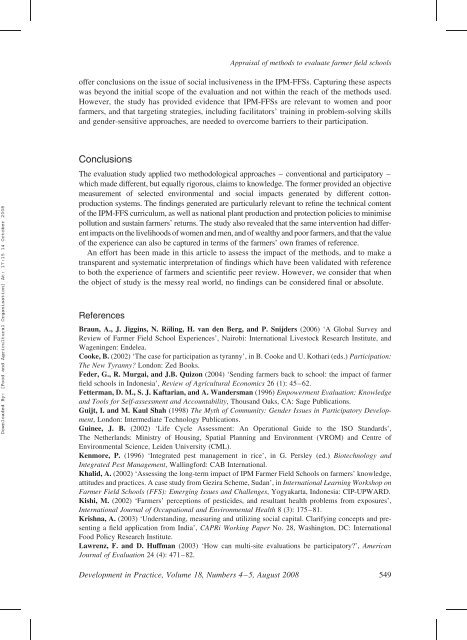Appraisal of methods to evaluate farmer field schools
Appraisal of methods to evaluate farmer field schools
Appraisal of methods to evaluate farmer field schools
You also want an ePaper? Increase the reach of your titles
YUMPU automatically turns print PDFs into web optimized ePapers that Google loves.
<strong>Appraisal</strong> <strong>of</strong> <strong>methods</strong> <strong>to</strong> <strong>evaluate</strong> <strong>farmer</strong> <strong>field</strong> <strong>schools</strong><strong>of</strong>fer conclusions on the issue <strong>of</strong> social inclusiveness in the IPM-FFSs. Capturing these aspectswas beyond the initial scope <strong>of</strong> the evaluation and not within the reach <strong>of</strong> the <strong>methods</strong> used.However, the study has provided evidence that IPM-FFSs are relevant <strong>to</strong> women and poor<strong>farmer</strong>s, and that targeting strategies, including facilita<strong>to</strong>rs’ training in problem-solving skillsand gender-sensitive approaches, are needed <strong>to</strong> overcome barriers <strong>to</strong> their participation.Downloaded By: [Food and Agricultural Organisation] At: 17:15 14 Oc<strong>to</strong>ber 2008ConclusionsThe evaluation study applied two methodological approaches – conventional and participa<strong>to</strong>ry –which made different, but equally rigorous, claims <strong>to</strong> knowledge. The former provided an objectivemeasurement <strong>of</strong> selected environmental and social impacts generated by different cot<strong>to</strong>nproductionsystems. The findings generated are particularly relevant <strong>to</strong> refine the technical content<strong>of</strong> the IPM-FFS curriculum, as well as national plant production and protection policies <strong>to</strong> minimisepollution and sustain <strong>farmer</strong>s’ returns. The study also revealed that the same intervention had differentimpacts on the livelihoods <strong>of</strong> women and men, and <strong>of</strong> wealthy and poor <strong>farmer</strong>s, and that the value<strong>of</strong> the experience can also be captured in terms <strong>of</strong> the <strong>farmer</strong>s’ own frames <strong>of</strong> reference.An effort has been made in this article <strong>to</strong> assess the impact <strong>of</strong> the <strong>methods</strong>, and <strong>to</strong> make atransparent and systematic interpretation <strong>of</strong> findings which have been validated with reference<strong>to</strong> both the experience <strong>of</strong> <strong>farmer</strong>s and scientific peer review. However, we consider that whenthe object <strong>of</strong> study is the messy real world, no findings can be considered final or absolute.ReferencesBraun, A., J. Jiggins, N. Röling, H. van den Berg, and P. Snijders (2006) ‘A Global Survey andReview <strong>of</strong> Farmer Field School Experiences’, Nairobi: International Lives<strong>to</strong>ck Research Institute, andWageningen: Endelea.Cooke, B. (2002) ‘The case for participation as tyranny’, in B. Cooke and U. Kothari (eds.) Participation:The New Tyranny? London: Zed Books.Feder, G., R. Murgai, and J.B. Quizon (2004) ‘Sending <strong>farmer</strong>s back <strong>to</strong> school: the impact <strong>of</strong> <strong>farmer</strong><strong>field</strong> <strong>schools</strong> in Indonesia’, Review <strong>of</strong> Agricultural Economics 26 (1): 45–62.Fetterman, D. M., S. J. Kaftarian, and A. Wandersman (1996) Empowerment Evaluation: Knowledgeand Tools for Self-assessment and Accountability, Thousand Oaks, CA: Sage Publications.Guijt, I. and M. Kaul Shah (1998) The Myth <strong>of</strong> Community: Gender Issues in Participa<strong>to</strong>ry Development,London: Intermediate Technology Publications.Guinee, J. B. (2002) ‘Life Cycle Assessment: An Operational Guide <strong>to</strong> the ISO Standards’,The Netherlands: Ministry <strong>of</strong> Housing, Spatial Planning and Environment (VROM) and Centre <strong>of</strong>Environmental Science, Leiden University (CML).Kenmore, P. (1996) ‘Integrated pest management in rice’, in G. Persley (ed.) Biotechnology andIntegrated Pest Management, Wallingford: CAB International.Khalid, A. (2002) ‘Assessing the long-term impact <strong>of</strong> IPM Farmer Field Schools on <strong>farmer</strong>s’ knowledge,attitudes and practices. A case study from Gezira Scheme, Sudan’, in International Learning Workshop onFarmer Field Schools (FFS): Emerging Issues and Challenges, Yogyakarta, Indonesia: CIP-UPWARD.Kishi, M. (2002) ‘Farmers’ perceptions <strong>of</strong> pesticides, and resultant health problems from exposures’,International Journal <strong>of</strong> Occupational and Environmental Health 8 (3): 175–81.Krishna, A. (2003) ‘Understanding, measuring and utilizing social capital. Clarifying concepts and presentinga <strong>field</strong> application from India’, CAPRi Working Paper No. 28, Washing<strong>to</strong>n, DC: InternationalFood Policy Research Institute.Lawrenz, F. and D. Huffman (2003) ‘How can multi-site evaluations be participa<strong>to</strong>ry?’, AmericanJournal <strong>of</strong> Evaluation 24 (4): 471–82.Development in Practice, Volume 18, Numbers 4–5, August 2008 549




![Section 4 [ PDF file, 252 KB] - The Field Alliance](https://img.yumpu.com/51387260/1/158x260/section-4-pdf-file-252-kb-the-field-alliance.jpg?quality=85)











